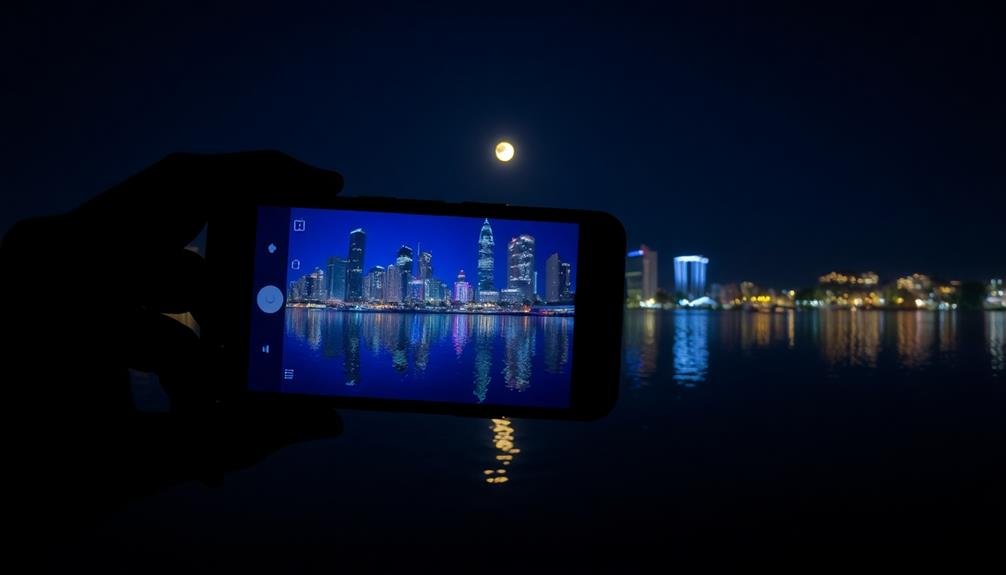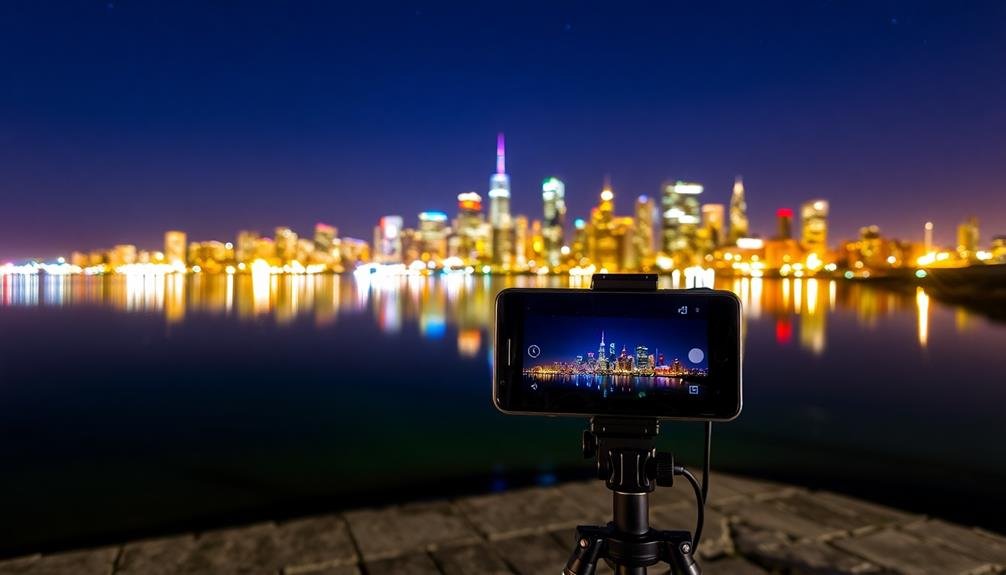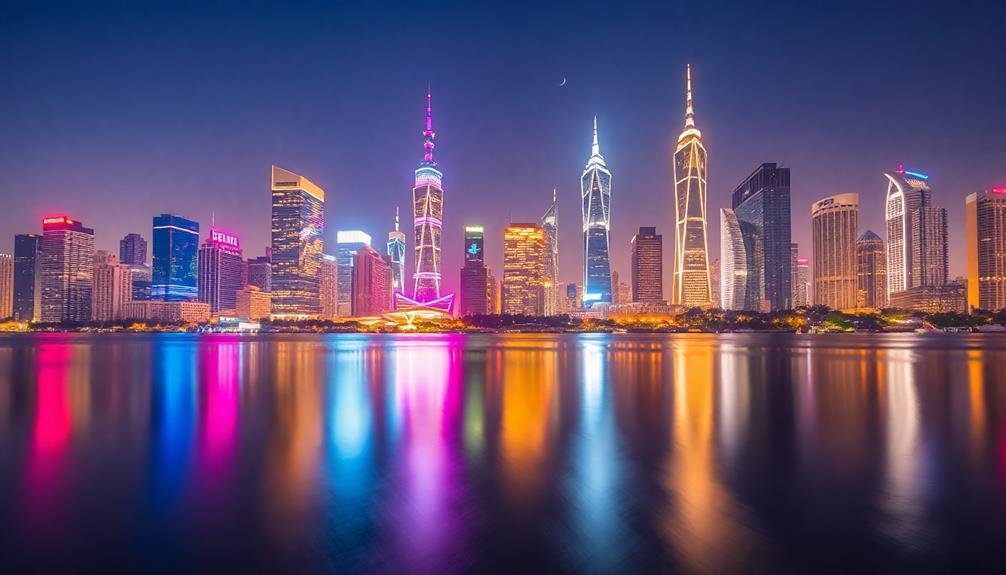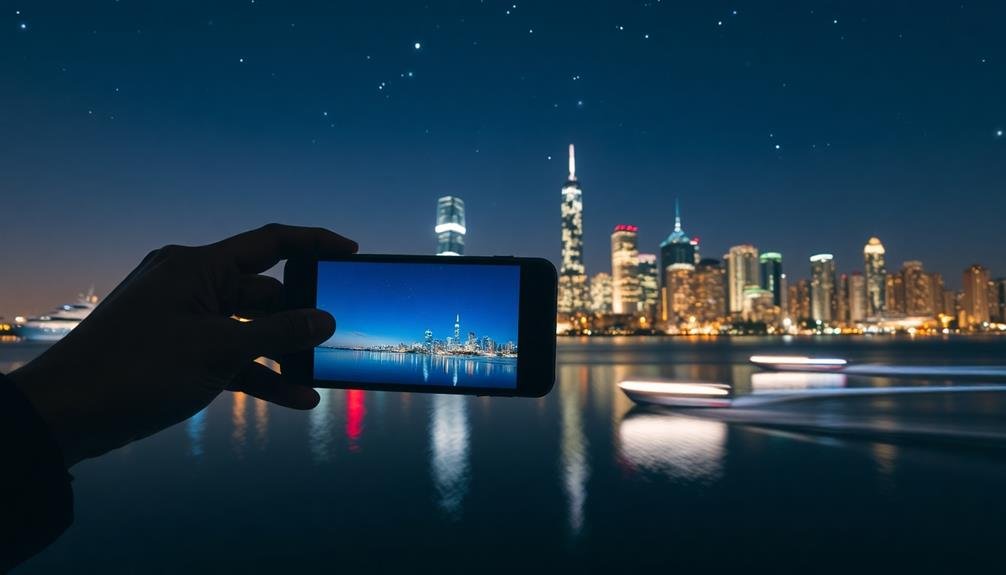To capture stunning night reflections with your phone camera, scout locations with calm water bodies or urban reflective surfaces. Switch to manual mode and use lower ISO settings (100-400) with slower shutter speeds (1-4 seconds) for crisp, detailed images. Compose your shots with symmetry in mind, applying the rule of thirds for dynamic results. Experiment with various light sources and angles to enhance reflections. Stabilize your phone using a tripod or solid surface to prevent blur. In post-processing, adjust exposure, contrast, and color balance to make your reflections pop. These pro tips will elevate your night photography game, but there's even more to explore in the world of reflective imagery.
Scouting Perfect Reflection Locations

When you're looking for stunning reflection shots, keep your eyes peeled for smooth, reflective surfaces. Water bodies like lakes, ponds, and puddles are prime candidates, especially on calm nights.
Urban environments offer unique opportunities with glass buildings, polished floors, and wet streets after rain. Scout locations during the day to identify potential spots, but return at night to capture the magic of artificial lighting.
Look for areas with interesting light sources nearby, such as street lamps, neon signs, or illuminated buildings. These elements will create enthralling reflections in your frame.
Consider the angle of your shot; sometimes, getting low to the ground can dramatically enhance the reflection's impact. Don't overlook unconventional surfaces like car hoods, metal sculptures, or even mirrors placed strategically in your composition.
Timing is essential for the perfect reflection shot. Visit your chosen locations at different times of night to find the ideal balance of ambient light and artificial illumination.
Be patient and wait for moments when foot traffic or vehicle movement subsides, allowing the reflective surface to settle and create a crisp, mirror-like image.
Camera Settings for Night Reflections

The right camera settings can make or break your night reflection shots. To capture stunning night reflections with your phone camera, you'll need to adjust several key settings.
First, switch to manual or pro mode if your phone offers it. This gives you more control over essential parameters.
Set your ISO between 100-400 to minimize noise while maintaining sensitivity. Use a slower shutter speed, typically between 1-4 seconds, to allow more light in and capture the reflection's detail. If your phone has aperture control, open it wide (lower f-number) for maximum light intake.
Enable your phone's night mode or long exposure feature if available. These use AI to combine multiple shots, reducing noise and enhancing detail. Turn on HDR to balance the bright lights and dark areas in your scene.
For sharper images, use a tripod or stabilize your phone against a solid surface. Enable your phone's timer or use a remote shutter to avoid camera shake when pressing the capture button.
Experiment with white balance settings to achieve the desired mood. Auto white balance often works well, but you might prefer cooler or warmer tones for artistic effect.
Composition Techniques for Mirrored Images

Now that you've mastered the technical aspects, let's focus on composition techniques for mirrored images. When shooting reflections at night, symmetry is your best friend. Position your camera so that the real scene and its reflection create a balanced, mirror-like image.
Look for strong vertical elements like buildings, trees, or lampposts that can divide your frame evenly.
Consider the rule of thirds when composing your shot. Place the horizon line along the top or bottom third of the frame, rather than directly in the center. This creates a more dynamic and visually appealing image.
Experiment with different angles and perspectives to find the most striking composition.
Don't be afraid to include foreground elements to add depth and interest to your mirrored images. A railing, bench, or even ripples in the water can create a compelling contrast to the smooth reflection.
Here are some additional tips to enhance your mirrored night shots:
- Use leading lines to draw the viewer's eye into the image
- Incorporate negative space to highlight the reflection
- Experiment with partial reflections for a more abstract look
Enhancing Reflections With Lighting

Lighting plays an essential role in enhancing reflections for stunning night photography. You'll want to experiment with different light sources to create enchanting effects. Use streetlights, neon signs, or even your phone's flashlight to illuminate reflective surfaces. Position yourself to capture the interplay between light and water, glass, or metallic objects.
Consider the angle of your light source relative to the reflective surface. Aim for a 45-degree angle to maximize the reflection's visibility. If you're shooting water reflections, try placing your light source low to the ground for a dramatic effect. For urban scenes, seek out areas with multiple light sources to create complex, layered reflections.
Here's a quick guide to enhancing reflections with different light sources:
| Light Source | Effect | Best For | Technique | Caution |
|---|---|---|---|---|
| Streetlights | Soft, warm glow | Urban scenes | Position subject near light | Avoid overexposure |
| Neon signs | Vibrant colors | Cityscapes | Frame sign in reflection | Balance exposure |
| Phone flashlight | Focused beam | Close-up details | Use indirect lighting | Avoid harsh shadows |
| Car headlights | Dynamic streaks | Traffic scenes | Slow shutter speed | Safety first |
| Moon | Natural, ethereal | Landscape reflections | Use long exposure | Check moon phase |
Remember to adjust your camera settings to compensate for low light conditions. Experiment with longer exposure times and higher ISO settings to capture more light and enhance the reflections in your night photography.
Post-Processing Tips for Reflection Photos

After capturing stunning reflection photos, post-processing can elevate your images to the next level. Start by adjusting the exposure and contrast to enhance the reflective surface's clarity.
Experiment with the highlights and shadows sliders to bring out details in both the reflected subject and the surrounding environment. Don't be afraid to crop your image to improve composition and focus on the most impactful elements of the reflection.
Next, fine-tune the color balance to create a cohesive look between the reflection and its source. You might want to slightly boost the saturation to make colors pop, especially in night scenes where artificial lights play a significant role.
Consider using selective editing tools to adjust specific areas of your photo without affecting the entire image.
To add a professional touch to your reflection photos, try these advanced techniques:
- Apply a gentle vignette to draw attention to the center of the image
- Use the dehaze tool to reduce any fog or mist that might be obscuring the reflection
- Experiment with split toning to create a unique color palette that enhances the mood of your photo
Frequently Asked Questions
How Do I Protect My Phone From Water Damage When Shooting Reflections?
To protect your phone from water damage when shooting reflections, you'll want to use a waterproof case or bag. You can also keep your device above water level and use a tripod for stability. Don't forget to wipe it dry afterwards.
Can I Use Lens Filters for Night Reflection Photography With Smartphones?
Yes, you can use lens filters for night reflection photography with smartphones. They'll enhance your shots by reducing glare, increasing contrast, or adding color effects. Clip-on filters are available for most phone models and are easy to attach.
What Apps Are Best for Planning Reflection Shots Based on Weather Conditions?
You'll find apps like PhotoPills, The Photographer's Ephemeris, and Clear Outside invaluable for planning reflection shots. They provide weather forecasts, sun/moon positions, and water conditions. Don't forget to check local tide apps for coastal reflections.
How Do I Prevent Condensation on My Phone's Camera Lens at Night?
To prevent condensation on your phone's camera lens at night, you'll want to keep it warm. Use a lens cloth, avoid sudden temperature changes, and store your phone in a pocket close to your body when not in use.
Are There Any Legal Considerations When Photographing Reflections in Urban Areas?
When photographing reflections in urban areas, you'll need to be aware of privacy laws. Don't capture images of private property without permission. Be cautious in public spaces, as some buildings or artworks may have copyright restrictions.
In Summary
You've now got the tools to capture stunning night reflections with your phone camera. Remember to scout ideal locations, adjust your settings, and compose your shots carefully. Don't forget to experiment with lighting and post-processing techniques to enhance your images. With practice, you'll master the art of capturing mesmerizing mirrored scenes after dark. So grab your phone and head out tonight to create some breathtaking reflection photos that'll wow your followers.





Leave a Reply